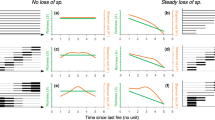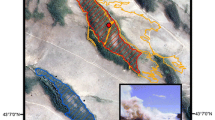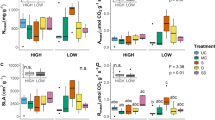Abstract
In the long-term absence of rejuvenating disturbances, forest succession frequently proceeds from a maximal biomass phase to a retrogressive phase characterized by reduced nutrient availability [notably nitrogen (N) and phosphorus (P)] and net primary productivity. Few studies have considered how retrogression induces changes in ecophysiological responses associated with photosynthetic carbon (C) gain, and only for trees. We tested the hypothesis that retrogression would negatively impact photosynthetic C gain of four contrasting species, and that this impact would be greater for vascular plants (i.e., trees and shrubs) than for non-vascular plants (i.e., mosses). We used a 5,000-year-old chronosequence of forested islands in Sweden, where retrogression occurs in the long-term absence of lightning-ignited wildfires. Despite fundamental differences in plant form and ecological niche among species, vascular plants and mosses showed similar ecophysiological responses to retrogression. The most common effects of retrogression were reductions in photosynthesis and respiration per unit foliar N, increases in foliar N, δ13C and δ15N, and decreases in specific leaf areas. In contrast, photosynthesis per unit mass or area generally did not change along the chronosequence, but did vary many-fold between vascular plants and mosses. The consistent increases in foliar N without corresponding increases in mass- or area-based photosynthesis suggest that other factor(s), such as P co-limitation, light conditions or water availability, may co-regulate C gain in retrogressive boreal forests. Against our predictions, traits of mosses associated with C and N were generally highly responsive to retrogression, which has implications for how mosses influence ecosystem processes in boreal forests.




Similar content being viewed by others
References
Anderson JM (1991) The effects of climate change on decomposition processes in grassland and coniferous forests. Ecol Appl 1:326–347
Bansal S, Germino MJ (2008) Carbon balance of conifer seedlings at timberline: relative changes in uptake, storage, and utilization. Oecologia 158:217–227
Bates JW (1992) Mineral nutrient acquisition and retension by bryophytes. J Bryol 17:223–240
Bond BJ, Franklin JF (2002) Aging in Pacific northwest forests: a selection of recent research. Tree Physiol 22:73
Brenner DL, Amundson R, Baisden WT, Kendall C, Harden J (2001) Soil N and 15N variation with time in a California annual grassland ecosystem. Geochim Cosmochim Acta 65:4171–4186
Cordell S, Goldstein G, Mueller-Dombois D, Webb D, Vitousek PM (1998) Physiological and morphological variation in Metrosideros polymorpha, a dominant Hawaiian tree species, along an altitudinal gradient: the role of phenotypic plasticity. Oecologia 113:188–196
Cordell S, Goldstein G, Meinzer FC, Vitousek PM (2001) Morphological and physiological adjustment to N and P fertilization in nutrient-limited Metrosideros polymorpha canopy trees in Hawaii. Tree Physiol 21:43–50
DeLuca TH, Nilsson M-C, Zackrisson O (2002) Nitrogen mineralization and phenol accumulation along a fire chronosequence in northern Sweden. Oecologia 133:206–214
Eckstein RL (2000) Nitrogen retention by Hylocomium splendens in a Subarctic Birch Woodland. J Ecol 88:506–515
Field C, Mooney HA (1986) The photosynthesis-nitrogen relationship in wild plants. In: Givnish TJ (ed) On the economy of plant form and function. Cambridge University Press, New York, pp 25–56
Fleck I, Diaz C, Pascual M, Iniguez FJ (1995) Ecophysiological differences between first-year resprouts after wildfire and unburned vegetation of Arbutus unedo and Coriaria myrtifolia. Acta Oecol Int J Ecol 16:55–69
Gilbert NL, Johnson SL, Gleeson SK, Blankenship BA, Arthur MA (2003) Effects of prescribed fire on physiology and growth of Acer rubrum and Quercus spp. seedlings in an oak-pine forest on the Cumberland Plateau, KY. J Torrey Bot Soc 130:253–264
Gorham E (1991) Northern peatlands: role in the carbon cycle and probable responses to climatic warming. Ecol Appl 1:182–195
Gundale MJ, Wardle DA, Nilsson M-C (2010) Vascular plant removal effects on biological N fixation vary across a boreal forest island gradient. Ecology 91:1704–1714
Gundale MJ, Fajardo A, Lucas RW, Nilsson M-C, Wardle DA (2011) Resource heterogeneity does not explain the productivity-diversity relationship across a boreal island fertility gradient. Ecography 34:887–896
Handley LL, Raven JA (1992) The use of natural abundance of nitrogen isotopes in plant physiology and ecology. Plant Cell Environ 15:965–985
He JS, Wang XP, Schmid B, Flynn DFB, Li XF, Reich PB, Fang JY (2010) Taxonomic identity, phylogeny, climate and soil fertility as drivers of leaf traits across Chinese grassland biomes. J Plant Res 123:551–561
Hörnberg G, Zackrisson O, Segerstrom U, Svensson BW, Ohlson M, Bradshaw RHW (1998) Boreal swamp forests. Bioscience 48:795–802
Hyodo F, Wardle DA (2009) Effect of ecosystem retrogression on stable nitrogen and carbon isotopes of plants, soils and consumer organisms in boreal forest islands. Rapid Commun Mass Spectrom 23:1892–1898
Joel G, Aplet G, Vitousek PM (1994) Leaf morphology along environmental gradient in Hawaiian Metrosideros polymorpha. Biotropica 26:232
Keeley DR (1980) Prediction of soil nitrogen availability in forest ecosystems: a literature review. For Sci 26:159–171
Kolari P, Pumpanen J, Kulmala L, Ilvesniemi H, Nikinmaa E, Gronholm T, Hari P (2006) Forest floor vegetation plays an important role in photosynthetic production of boreal forests. For Ecol Manag 221:241–248
Kruger EL, Reich PB (1997) Responses of hardwood regeneration to fire in mesic forest openings. II. Leaf gas exchange, nitrogen concentration, and water status. Can J Res Rev Can Rech For 27:1832–1840
Lagerström A, Nilsson M-C, Zackrisson O, Wardle DA (2007) Ecosystem input of nitrogen through biological fixation in feather mosses during ecosystem retrogression. Funct Ecol 21:1027–1033
Lagerström A, Esberg C, Wardle DA, Giesler R (2009) Soil phosphorus and microbial response to a long-term wildfire chronosequence in northern Sweden. Biogeochem 95:199–213
Lambers H, Raven JA, Shaver GR, Smith SE (2008) Plant nutrient-acquisition strategies change with soil age. Trends Ecol Evol 23:95–103
Lamont BB, Groom PK, Cowling RM (2002) High leaf mass per area of related species assemblages may reflect low rainfall and carbon isotope discrimination rather than low phosphorus and nitrogen concentrations. Funct Ecol 16:403–412
Marshall JD, Zhang JW (1994) Carbon isotope discrimination and water-use efficiency in native plants of the north-central rockies. Ecology 75:1887–1895
Menge DNL, Troy Baisden W, Richardson SJ, Peltzer DA, Barbour MM (2011) Declining foliar and litter δ15N diverge from soil, epiphyte and input δ15N along a 1,20,000 yr temperate rainforest chronosequence. New Phytol 190:941–952
Nilsson M-C, Wardle DA (2005) Understory vegetation as a forest ecosystem driver: evidence from the northern Swedish boreal forest. Front Ecol Environ 3:421–428
Oechel WC, Van Cleve K (1986) The role of bryophytes in nutrient cycling in the taiga. In: Van Cleve K, Chapin SF III, Flanagan PW, Viereck LA, Dyrness CT (eds) Forest ecosystems in the Alaskan taiga. Springer, New York, pp 121–137
Peltzer DA, Wardle DA, Allison VJ, Baisden WT, Bardgett RD, Chadwick OA, Condron LM, Parfitt RL, Porder S, Richardson SJ, Turner BL, Vitousek PM, Walker J, Walker LR (2010) Understanding ecosystem retrogression. Ecol Monogr 80:509–529
Poorter H, Remkes C (1990) Leaf area ratio and net assimilation rate of 24 wild species differing in relative growth rate. Oecologia 83:553–559
Proctor MCF (2000) The bryophyte paradox: tolerance of desiccation, evasion of drought. Plant Ecol 151:41–49
Proctor MCF, Oliver MJ, Wood AJ, Alpert P, Stark LR, Cleavitt NL, Mishler BD (2007) Desiccation-tolerance in bryophytes: a review. Bryologist 110:595–621
Richardson SJ, Peltzer DA, Allen RB, McGlone MS, Parfitt RL (2004) Rapid development of phosphorus limitation in temperate rainforest along the Franz Josef soil chronosequence. Oecologia 139:267–276
Richardson SJ, Allen RB, Doherty JE (2008) Shifts in leaf N:P ratio during resorption reflect soil P in temperate rainforest. Funct Ecol 22:738–745
Ryan MG (1995) Foliar maintenance respiration of subalpine and boreal trees and shrubs in relation to nitrogen content. Plant Cell Environ 18:765–772
Shaw J, Renzaglia K (2004) Phylogeny and diversification of bryophytes. Am J Bot 91:1557–1581
Skre O, Oechel WC (1981) Moss functioning in different taiga ecosystems in interior Alaska. I. Seasonal, phenotypic, and drought effects on photosynthesis and response patterns. Oecologia 48:50–59
Swanson RV, Flanagan LB (2001) Environmental regulation of carbon dioxide exchange at the forest floor in a boreal black spruce ecosystem. Agric For Meteorol 108:165–181
Thornton LE, Keren N, Ohad I, Pakrasi HB (2005) Physcomitrella patens and Ceratodon purpureus, mosses as model organisms in photosynthesis studies. Photosynth Res 83:87–96
Tobias M, Niinemets U (2010) Acclimation of photosynthetic characteristics of the moss Pleurozium schreberi to among-habitat and within-canopy light gradients. Plant Biol 12:743–754
Turnbull MH, Tissue DT, Griffin KL, Richardson SJ, Peltzer DA, Whitehead D (2005) Respiration characteristics in temperate rainforest tree species differ along a long-term soil-development chronosequence. Oecologia 143:271–279
Vitousek PM (2004) Nutrient cycling and limitation. Hawaii as a model system. Princeton University Press, New Jersey
Vitousek PM, Shearer G, Kohl DH (1989) Foliar 15N natural abundance in Hawaiian rainforest: patterns and possible mechanisms. Oecologia 78:383–388
Vitousek PM, Field CB, Matson PA (1990) Variation in foliar δ13C in Hawaiian Metrosideros polymorpha: a case of internal resistance? Oecologia 84:362–370
Waite M, Sack L (2010) How does moss photosynthesis relate to leaf and canopy structure? Trait relationships for 10 Hawaiian species of contrasting light habitats. New Phytol 185:156–172
Waite M, Sack L (2011) Does global stoichiometric theory apply to bryophytes? Tests across an elevation × soil age ecosystem matrix on Mauna Loa, Hawaii. J Ecol 99:122–134
Wardle DA, Zackrisson O (2005) Effects of species and functional group loss on island ecosystem properties. Nature 435:806–810
Wardle DA, Zackrisson O, Hornberg G, Gallet C (1997) The influence of island area on ecosystem properties. Science 277:1296–1299
Wardle DA, Hornberg G, Zackrisson O, Kalela-Brundin M, Coomes DA (2003) Long-term effects of wildfire on ecosystem properties across an island area gradient. Science 300:972–975
Wardle DA, Walker LR, Bardgett RD (2004) Ecosystem properties and forest decline in contrasting long-term chronosequences. Science 305:509–513
Walker LR, del Moral R (2003) Primary succession and ecosystem rehabilitation. Cambridge University Press, Cambridge
Walker TW, Syers JK (1976) The fate of phosphorus during pedogenesis. Geoderma 15:1–19
Walker J, Thompson CH, Fergus IF, Tunstall BR (1981) Plant succession and soil development in coastal sand dunes of subtropical eastern Australia. In: West DC, Shuguart HH, Botkin DB (eds) Forest succession. Concepts and application. Springer, New York, pp 107–131
Warren CR, Adams MA (2002) Phosphorus affects growth and partitioning of nitrogen to rubisco in Pinus pinaster. Tree Physiol 22:11–19
Whelan T, Sackett WM, Benedict CR (1973) Enzymatic fractionation of carbon isotopes by phosphoenolpyruvate carboxylase from C4 plants. Plant Physiol 51:1051–1054
Whitehead D, Boelman NT, Turnbull MH, Griffin KL, Tissue DT, Barbour MM, Hunt JE, Richardson SJ, Peltzer DA (2005) Photosynthesis and reflectance indices for rainforest species in ecosystems undergoing progression and retrogression along a soil fertility chronosequence in New Zealand. Oecologia 144:233–244
Winner WE, Thomas SC, Berry JA, Bond BJ, Cooper CE, Hinckley TM, Ehleringer JR, Fessenden JE, Lamb B, McCarthy S (2004) Canopy carbon gain and water use: analysis of old-growth conifers in the Pacific northwest. Ecosystems 7:482–497
Wright IJ, Reich PB, Westoby M, Ackerly DD, Baruch Z, Bongers F et al (2004) The worldwide leaf economics spectrum. Nature 428:821–827
Zackrisson O (1977) Influence of forest fires on northern Swedish boreal forests. Oikos 29:22–32
Zackrisson O, Nilsson M-C, Dahlberg A, Jäderlund A (1997) Interference mechanisms in conifer-ericaceae-feathermoss communities. Oikos 78:209–220
Zackrisson O, DeLuca TH, Nilsson M-C, Sellstedt A, Berglund LM (2004) Nitrogen fixation increases with successional age in boreal forests. Ecology 85:3327–3334
Acknowledgments
We thank Dr. Waite for help in the design and Unimeg at Umeå University for construction of the customized gas exchange chamber to measure moss photosynthesis, Elin Norlin for help in acquiring the portable gas exchange system and performing isotope analyses, Tim Steinkraus for assistance in the field, and four anonymous reviewers for helpful comments on the manuscript. This work was funded by a Swedish Research Council (Vetenskapsrådet) grant and a Wallenberg Scholars award to D.A.W., and a SLU grant awarded to M.C.N.
Author information
Authors and Affiliations
Corresponding author
Additional information
Communicated by Frederick Meinzer.
Electronic supplementary material
Below is the link to the electronic supplementary material.
Rights and permissions
About this article
Cite this article
Bansal, S., Nilsson, MC. & Wardle, D.A. Response of photosynthetic carbon gain to ecosystem retrogression of vascular plants and mosses in the boreal forest. Oecologia 169, 661–672 (2012). https://doi.org/10.1007/s00442-011-2246-z
Received:
Accepted:
Published:
Issue Date:
DOI: https://doi.org/10.1007/s00442-011-2246-z




